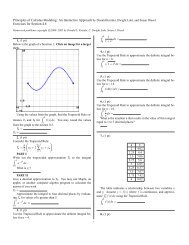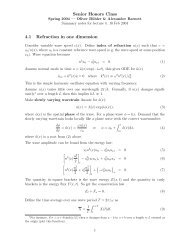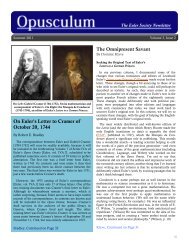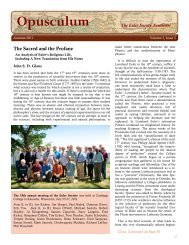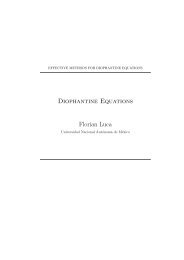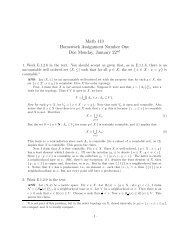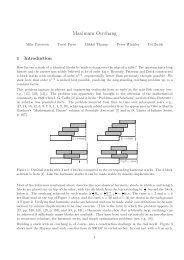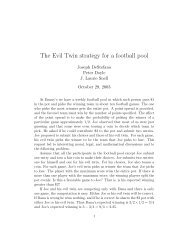ON CONGRUENCES OF THE FORM σ(n) ≡ a (mod n) Aria Anavi ...
ON CONGRUENCES OF THE FORM σ(n) ≡ a (mod n) Aria Anavi ...
ON CONGRUENCES OF THE FORM σ(n) ≡ a (mod n) Aria Anavi ...
You also want an ePaper? Increase the reach of your titles
YUMPU automatically turns print PDFs into web optimized ePapers that Google loves.
<strong>ON</strong> C<strong>ON</strong>GRUENCES <strong>OF</strong> <strong>THE</strong> <strong>FORM</strong> <strong>σ</strong>(n) <strong>≡</strong> a (<strong>mod</strong> n)<br />
<strong>Aria</strong> <strong>Anavi</strong><br />
aria.anavi@gmail.com<br />
Paul Pollack<br />
Department of Mathematics, University of British Columbia, Vancouver, BC V6T 1Z2, Canada<br />
Department of Mathematics, Simon Fraser University, Burnaby, BC V5A 1S6, Canada<br />
pollack@math.ubc.ca<br />
Carl Pomerance<br />
Department of Mathematics, Dartmouth College, Hanover, NH 03755, USA<br />
carlp@math.dartmouth.edu<br />
Abstract<br />
We study the distribution of solutions n to the congruence <strong>σ</strong>(n) <strong>≡</strong> a (<strong>mod</strong> n). After<br />
excluding obvious families of solutions, we show that the number of these n ≤ x is<br />
at most x 1/2+o(1) , as x → ∞, uniformly for integers a with |a| ≤ x 1/4 . As a concrete<br />
example, the number of composite solutions n ≤ x to the congruence <strong>σ</strong>(n) <strong>≡</strong> 1 (<strong>mod</strong> n)<br />
is at most x 1/2+o(1) . These results are analogues of theorems established for the Euler<br />
ϕ-function by the third-named author.<br />
1. Introduction<br />
In this paper, we continue the investigations of the third-named author [Pom75, Pom76,<br />
Pom77] into the congruences<br />
n <strong>≡</strong> a (<strong>mod</strong> ϕ(n)) (1.1)<br />
and<br />
<strong>σ</strong>(n) <strong>≡</strong> a (<strong>mod</strong> n). (1.2)<br />
These congruences have connections to various unsolved problems in number theory.<br />
Most prominent among these is Lehmer’s question [Leh32] of whether there are any<br />
composite solutions to (1.1) when a = 1. We also note here the many classical problems<br />
concerning multiply perfect numbers, which are those n satisfying (1.2) with a = 0.<br />
It is observed in [Pom75] that for both (1.1) and (1.2), there is a natural classification<br />
of solutions as either regular or sporadic. For (1.1), there are no regular solutions unless<br />
a > 0 and ϕ(a) | a; in that case, we define a regular solution as a number n of the form<br />
pa, where p is a prime not dividing a. By a regular solution to (1.2), we mean a natural<br />
number n of the form<br />
n = pm, where p ∤ m, m | <strong>σ</strong>(m), and <strong>σ</strong>(m) = a. (1.3)<br />
(It is straightforward to check that these “regular solutions” really are solutions.) In<br />
both cases, all other solutions are called sporadic. From the prime number theorem, it<br />
is easily seen that if there are any regular solutions to (1.1) or (1.2), then the number<br />
1
of such up to x is ≍ x for large x. In [Pom75, Theorem 3], it is shown that sporadic<br />
log x<br />
solutions are much rarer: For any fixed a, the number of sporadic solutions to either<br />
(1.1) or (1.2) is at most<br />
<br />
1 log<br />
x/ exp √2 + o(1) x log log x , as x → ∞. (1.4)<br />
For solutions to the ϕ-congruence (1.1), the upper bound (1.4) has seen substantial<br />
improvement, first to x 2/3+o(1) [Pom76] and soon after to x 1/2+o(1) [Pom77] (both results<br />
are again for fixed a). There has been a fair amount of work chipping away at the size<br />
of the o(1)-term in the exponent of this last result [Sha85, BL07, BGN08, LP], but a<br />
new idea will be required to replace 1 with anything smaller.<br />
2<br />
All of the results of the last paragraph apply only to (1.1) and not the <strong>σ</strong>-version<br />
(1.2). The behavior of the Euler ϕ-function on prime powers is much simpler than that<br />
of <strong>σ</strong>, and complications arise if one tries to mimic the arguments of [Pom76, Pom77].<br />
Recently, the second-named author and V. Shevelev described how to overcome these<br />
difficulties for the arguments of [Pom76], proving that the sporadic solutions in [1, x]<br />
to (1.2) number at most x2/3+o(1) [PS, Lemma 8]. (In fact, their result is uniform for<br />
|a| < x 2/3 .) The purpose of this note is to reduce the exponent 2<br />
3<br />
to 1<br />
2 .<br />
Theorem 1. As x → ∞, the number of sporadic solutions n ≤ x to the congruence<br />
(1.2) is at most<br />
A(a)x 1/2 <br />
exp (2 + o(1))<br />
log x<br />
log log x<br />
, (1.5)<br />
uniformly in integers a with |a| ≤ x1/4 . Here A is defined by A(0) := 1 and, for a = 0,<br />
A(a) := <br />
<br />
1 + b2 <br />
+ b<br />
. (1.6)<br />
2<br />
p b a<br />
Remark 1. The factor A in (1.5) is fairly tame, displaying similar behavior to the number<br />
of divisors of a. In particular, a theorem of Drozdova and Freĭman [DF58] (see also<br />
[Pos88, Chapter 4]) yields<br />
<br />
<br />
log |a|<br />
A(a) ≤ exp (log 2 + o(1))<br />
, as |a| → ∞.<br />
log log |a|<br />
(This should be compared with [HaWr08, Theorem 317, p. 345], where the same inequality<br />
is proved for the usual divisor function.) Hence, the bound (1.5) is indeed of<br />
the shape x 1/2+o(1) , uniformly for |a| ≤ x 1/4 . Thus (apart from secondary terms), (1.2)<br />
is no longer a second-class citizen compared to (1.1); both congruences are now on the<br />
same theoretical footing.<br />
It seems plausible that the upper bound (1.5) can be replaced with a bounded power<br />
of log x, even in the wider range |a| ≤ x/2. See Remark 3(i) at the end of this paper. If<br />
this is correct, we have a long way to go!<br />
We mention briefly an application of Theorem 1 to a problem considered in [PS]. Call<br />
a natural number n a near-perfect number if n is the sum of all of its proper divisors<br />
with one exception. In other words, n is near-perfect if <strong>σ</strong>(n) = 2n + d for some proper<br />
2
divisor d of n. Using Theorem 1, we can show that the number of near-perfect n ≤ x<br />
is at most x3/4+o(1) , as x → ∞. This result with exponent 5 appeared as Theorem 5<br />
6<br />
of [PS]. We omit the proof of our improvement, which essentially amounts to replacing<br />
[PS, Lemma 8] with the estimate (1.5).<br />
Notation<br />
As above, we employ the Landau–Bachmann o and O symbols, as well as Vinogradov’s<br />
≪ notation, with their usual meanings. All of our implied constants are absolute.<br />
The letter p, with or without subscripts, always denotes a prime variable. We write<br />
π(x) = <br />
p≤x 1 for the number of primes not exceeding x. We say that d is a unitary<br />
divisor of n if d divides n and gcd(d, n/d) = 1. If p is a prime, the notation pe n means<br />
that pe | n but that pe+1 ∤ n. The number of divisors of n is denoted τ(n). We use<br />
ω(n) for the number of distinct prime divisors of n and Ω(n) for the number of primes<br />
dividing n counted with multiplicity; thus, ω(n) = <br />
<br />
p|n 1 and Ω(n) = pk |n 1. We write<br />
rad(n) for the radical of n, that is, the product of the distinct primes dividing n. We<br />
use P (n) to denote the largest prime factor of n, with the convention that P (1) = 1.<br />
2. Preparation<br />
For the reader’s convenience, we record here some simple inequalities for the abundancy<br />
ratio <strong>σ</strong>(n)<br />
n .<br />
Lemma 2. All of the following hold:<br />
(i) For all integers n ≥ 1, we have <strong>σ</strong>(n)<br />
n<br />
(ii) If d divides n, then <strong>σ</strong>(d)<br />
d<br />
≤ 1 + log n.<br />
<strong>σ</strong>(n)<br />
≤ , with equality only if d = n.<br />
n<br />
(iii) If p1 is the least prime dividing n, then <strong>σ</strong>(n)<br />
n ≤<br />
ω(n) p1 .<br />
p1−1<br />
Proof. Both (i) and (ii) follow from the representation <strong>σ</strong>(n)<br />
1<br />
d|n d<br />
1 ≤ d≤n d ≤ 1 + n dt<br />
1 t<br />
<strong>σ</strong>(n)<br />
n<br />
= <br />
p e n<br />
<br />
1 + 1<br />
p<br />
n<br />
= <br />
d|n<br />
= 1 + log n. For (iii), we observe that<br />
<br />
1<br />
+ + . . . ≤<br />
p2 <br />
p|n<br />
p<br />
p − 1 ≤<br />
ω(n) p1<br />
.<br />
p1 − 1<br />
1;<br />
we also use that<br />
d<br />
We also need a technical lemma from the “anatomy of integers” concerning numbers<br />
n ≤ x with small radical. The next result is due to de Koninck and Doyon (compare<br />
with [DKD03, Théorème 4]).<br />
Lemma 3. For each fixed z ≥ 1, we have (as x → ∞)<br />
<br />
1 ≤ x 1/z <br />
<br />
2(1 − 1/z) log x<br />
exp (2 + o(1))<br />
.<br />
log log x<br />
d≤x 1/z<br />
e≤x<br />
d|e, rad(e)=rad(d)<br />
3
Actually, de Koninck and Doyon prove the upper bound of Lemma 3 for the number<br />
of n ≤ x with rad(n) < n1/z , which is a smaller quantity than that considered in Lemma<br />
3. However, the first step in their proof (see [DKD03, eq. (19)]) is to bound that above<br />
by the double-sum <br />
1.<br />
d P (n) with <strong>σ</strong>(nq)<br />
nq<br />
> k.<br />
Proof. Since kn + a = <strong>σ</strong>(n) ≥ n > |a|, clearly k ≥ 1. Suppose for the sake of contradiction<br />
that k = 1. If n is composite with smallest prime factor p, then<br />
a = <strong>σ</strong>(n) − n = <br />
d ≥ n/p ≥ √ n > |a|,<br />
d|n, d 0. Now if d is a unitary divisor of n with d < n, then d<br />
4<br />
< k,
divides n/p e for some prime power p e n. By Lemma 2(ii), we may restrict attention<br />
to the case when d = n/p e . In this case,<br />
and so<br />
a = <strong>σ</strong>(n) − kn = <strong>σ</strong>(p e )<strong>σ</strong>(d) − kdp e<br />
= (p e + <strong>σ</strong>(p e−1 ))<strong>σ</strong>(d) − kdp e = p e (<strong>σ</strong>(d) − kd) + <strong>σ</strong>(p e−1 )<strong>σ</strong>(d),<br />
<strong>σ</strong>(d) − kd = a − <strong>σ</strong>(pe−1 )<strong>σ</strong>(d)<br />
p e . (2.1)<br />
Let us show that the right-hand side of (2.1) is negative. This is easy if e > 1; then<br />
<strong>σ</strong>(p e−1 )<strong>σ</strong>(d) ≥ p e−1 d ≥ (p e d) 1/2 = n 1/2 > a,<br />
and so we have (ii) in this case. Suppose e = 1. If d > a, then the right-hand side of<br />
(2.1) is again negative, and so we again have (ii). So we can assume that d ≤ a. Since<br />
n = pd > a2 , we must have p > a. But then the right-hand side of (2.1) is smaller than<br />
1, and hence 0 or negative (since the left-hand side of (2.1) is an integer). But it cannot<br />
equal zero, since otherwise <strong>σ</strong>(d) = a = kd, making n = pd a regular solution to (1.2)<br />
instead of a sporadic solution. This completes the proof of (ii).<br />
Finally, we prove (iii). If a > 0, then we can take any prime q > P (n). So we suppose<br />
that a < 0. Let p := P (n) be the largest prime factor of n. We will show below that<br />
p ≤ n . Assuming this for now, we can take q to be any prime in the interval (p, 2p].<br />
2|a|<br />
(Such a choice exists by Bertrand’s postulate.) Indeed, since q ≤ n , we have<br />
|a|<br />
<strong>σ</strong>(nq)<br />
nq =<br />
<br />
k + a<br />
<br />
n<br />
<br />
1 + 1<br />
<br />
q<br />
<br />
≥ k 1 − |a|<br />
<br />
1 +<br />
nk<br />
|a|<br />
<br />
= k +<br />
n<br />
|a|k<br />
<br />
1 −<br />
n<br />
1<br />
<br />
|a|<br />
− .<br />
k nk<br />
Since |a| < n and k ≥ 2 (by part (i) of the lemma), the final parenthesized expression is<br />
> k, as desired.<br />
. Write<br />
positive, and so <strong>σ</strong>(nq)<br />
nq<br />
It remains to prove the upper bound on p. Suppose instead that p > n<br />
2|a|<br />
n = p e d, where p e n. Since n > 4|a| 2 , we have p > √ n, and so e = 1. By (ii), we know<br />
that kd − <strong>σ</strong>(d) ≥ 1, so that from (2.1) and Lemma 2(i),<br />
p =<br />
<strong>σ</strong>(d) − a<br />
kd − <strong>σ</strong>(d)<br />
using d = n/p < 2|a|. It follows that<br />
≤ |a| + <strong>σ</strong>(d) ≤ |a| + d(1 + log d) ≤ |a| + 2|a|(1 + log (2|a|)),<br />
n = pd < 2a 2 + 4a 2 (1 + log (2|a|))<br />
< 6a 2 (1 + log (2|a|)) < 6a 2 log (6|a|).<br />
But this contradicts the lower bound on n assumed in the lemma statement.<br />
Lemma 6. Suppose a = 0. Let n be a sporadic solution to the congruence <strong>σ</strong>(n) <strong>≡</strong> a<br />
(<strong>mod</strong> n) with n > 6a 2 log (6|a|). Write<br />
For 0 ≤ i ≤ t − 1, we have<br />
n = p1p2 · · · pt, where p1 ≤ p2 ≤ p3 ≤ · · · ≤ pt.<br />
pi+1 ≤ ∆p1 · · · pi, where ∆ := 8(log n) 2 . (2.2)<br />
5
Proof. With k ≥ 2 as in the statement of Lemma 5(i), fix a prime q > P (n) so that<br />
<strong>σ</strong>(nq)<br />
nq > k, and put N := nq. Now let 0 ≤ i ≤ t − 1. If pi+1 = pi, then the desired<br />
inequality (2.2) is obvious (since ∆ ≥ 1), and so we can assume that pi+1 > pi. Then<br />
d := p1 · · · pi is a unitary divisor of N and the least prime factor of N/d is pi+1. Recalling<br />
Lemma 2(iii), we see that<br />
k < <strong>σ</strong>(N)<br />
ω(N/d) <strong>σ</strong>(d) <strong>σ</strong>(N/d) <strong>σ</strong>(d) pi+1<br />
= ≤ .<br />
N d N/d d pi+1 − 1<br />
Rearranging this inequality, we find that<br />
1 − ω(N/d)<br />
pi+1<br />
≤<br />
<br />
1 − 1<br />
pi+1<br />
ω(N/d)<br />
≤ <strong>σ</strong>(d)<br />
kd ,<br />
which after some manipulation shows that<br />
<br />
pi+1 ≤ ω(N/d) 1 − <strong>σ</strong>(d)<br />
−1 kd<br />
kd<br />
= ω(N/d) ≤ ω(N/d)kd. (2.3)<br />
kd − <strong>σ</strong>(d)<br />
(For the last inequality, we use that kd − <strong>σ</strong>(d) ≥ 1, as established in Lemma 5(ii).)<br />
log n<br />
Moreover, using the crude bound ω(n) ≤ Ω(n) ≤ and Lemma 2(i), we have<br />
log 2<br />
<br />
log n <strong>σ</strong>(n) |a|<br />
ω(N/d)k ≤ (1 + ω(n))k ≤ 1 + +<br />
log 2 n n<br />
<br />
log n<br />
≤ 1 + (2 + log n) < 8(log n)<br />
log 2<br />
2 = ∆.<br />
(The last inequality here follows from a simple calculation, using that log n > 1.) Since<br />
d = p1 · · · pi, the desired inequality (2.2) now follows from (2.3).<br />
Lemma 7. Suppose a = 0. Let n be a sporadic solution to the congruence <strong>σ</strong>(n) <strong>≡</strong> a<br />
(<strong>mod</strong> n) with n > 6a2 log (6|a|). Let x > 1, and suppose that n ∈ (x1/2 , x]. Then there<br />
is a divisor d of n with<br />
x1/2 64(log x) 4 < d ≤ x1/2 . (2.4)<br />
Proof. Write n = p1 · · · pt, with p1 ≤ p2 ≤ · · · ≤ pt. Let ai = log pi for 1 ≤ i ≤ t. Set<br />
δ := log (8(log x) 2 ). Then from (2.2), we have<br />
i<br />
ai+1 ≤ δ + aj for 0 ≤ i ≤ t − 1.<br />
j=1<br />
In particular, taking i = 0, we see that a1 ≤ δ. Applying Lemma 4, we obtain the<br />
existence of a subset I ⊂ {1, 2, . . . , t} with<br />
(log √ x) − 2δ < <br />
log ai ≤ log √ x.<br />
Exponentiating now gives the desired result.<br />
i∈I<br />
Remark 2. More generally, for any 1 ≤ y ≤ x 1/2 , the method of proof of Lemma 7 shows<br />
that n has a divisor in the interval (y/(64(log x) 4 ), y]. Thus, the divisors of n are dense,<br />
in the sense of Saias [Sai97]. We will only need the case y = x 1/2 , however.<br />
6
3. Proof of Theorem 1<br />
Proof of Theorem 1. If a = 0, then the n satisfying (1.2) are precisely the multiply<br />
perfect numbers. According to a theorem of Hornfeck and Wirsing [HoWi57, Satz 2],<br />
the number of these n ≤ x is x o(1) , as x → ∞, which is a much stronger bound than<br />
what is claimed in Theorem 1. So we can assume that a = 0. We can also assume that<br />
n > max{x 1/2 , 6a 2 log(6|a|)};<br />
indeed, since |a| ≤ x 1/4 , this inequality excludes ≪ x 1/2 log x values of n, which is<br />
acceptable. So by Lemma 7, there is a divisor d of n satisfying (2.4). Given d, let e be<br />
the (unique) unitary divisor of n with rad(e) = rad(d); note that d | e. Since e | n and<br />
<strong>σ</strong>(e) | <strong>σ</strong>(n), (1.2) implies the simultaneous congruences<br />
<strong>σ</strong>(n) <strong>≡</strong> a (<strong>mod</strong> e) and <strong>σ</strong>(n) <strong>≡</strong> 0 (<strong>mod</strong> <strong>σ</strong>(e)).<br />
By the Chinese remainder theorem, <strong>σ</strong>(n) belongs to a uniquely determined residue class<br />
<strong>mod</strong>ulo lcm[e, <strong>σ</strong>(e)]. Since <strong>σ</strong>(n) ≤ n(1 + log n) ≤ 2x log x, the number of possibilities for<br />
<strong>σ</strong>(n), given d and e, is at most<br />
2x log x<br />
+ 1.<br />
lcm[e, <strong>σ</strong>(e)]<br />
Now we sum over the possible pairs d, e. Since d ≤ x1/2 , d | e, and rad(e) = rad(d),<br />
we obtain from Lemma 3 (with z = 2) that<br />
<br />
<br />
2x log x<br />
+ 1 ≤<br />
lcm[e, <strong>σ</strong>(e)]<br />
d,e<br />
2x log x<br />
lcm[e, <strong>σ</strong>(e)]<br />
d,e<br />
+ x1/2 <br />
log x<br />
exp (2 + o(1))<br />
. (3.1)<br />
log log x<br />
The second right-hand term is acceptable for us, and so we concentrate on estimating<br />
, we see that<br />
the remaining double sum. Writing lcm[e, <strong>σ</strong>(e)] = e<strong>σ</strong>(e)<br />
gcd(e,<strong>σ</strong>(e))<br />
<br />
d,e<br />
2x log x<br />
lcm[e, <strong>σ</strong>(e)]<br />
≤ 2x log x <br />
d,e<br />
gcd(e, <strong>σ</strong>(e))<br />
e 2 . (3.2)<br />
Since <strong>σ</strong>(n) <strong>≡</strong> a (<strong>mod</strong> n) and gcd(e, <strong>σ</strong>(e)) divides both <strong>σ</strong>(n) and n, it must be that<br />
gcd(e, <strong>σ</strong>(e)) divides a. Moreover, if we define an arithmetic function τ ′ by setting<br />
τ ′ (m) :=<br />
<br />
1,<br />
g|m<br />
rad(g)=rad(m)<br />
then given e, there are only τ ′ (e) possibilities for d. Hence, writing u = gcd(e, <strong>σ</strong>(e)) and<br />
e = uf,<br />
<br />
d,e<br />
gcd(e, <strong>σ</strong>(e))<br />
e 2<br />
≤ <br />
u<br />
u|a<br />
<br />
x1/2 64u(log x) 4
y a divisor of f, so that τ ′ (uf) ≤ τ ′ (u)τ(f).) Let S(t) := <br />
m≤t τ(m). It is well-known<br />
(see, for example, [HaWr08, Theorem 18, p. 347]) that S(t) ≪ t log t. Hence,<br />
<br />
∞<br />
τ(f)<br />
≤<br />
f 2<br />
dS(t)<br />
t2 ≪<br />
∞<br />
x1/2 64u(log x) 4 √ x<br />
m|<strong>σ</strong>(m)<br />
1<br />
m .
Using partial summation in combination with the upper bound of Hornfeck and<br />
Wirsing [HoWi57, Satz 2] alluded to above, the first of the two remaining sums<br />
is absolutely bounded, while the latter is at most x −1/2+o(1) , as x → ∞. Hence,<br />
<br />
|a|≤x/2 S′ a(x) ≪ x/ log x. Combining this with (3.4), we obtain an asymptotic<br />
result on the average number of sporadic solutions:<br />
1<br />
x<br />
<br />
|a|≤x/2<br />
S ′′<br />
a(x) = log x + O(1).<br />
This motivates the conjecture, already appearing in the introduction, that S ′′<br />
a(x) ≤<br />
(log x) O(1) whenever x ≥ 3 and |a| ≤ x/2.<br />
(ii) Since the issue of uniformity seems to have been neglected in prior studies of the<br />
ϕ-congruence (1.1), we point out that the proof of Theorem 1 can be adapted<br />
to establish an upper bound of the form τ(|a|)x 1/2 (log x) O(1) for the number of<br />
sporadic solutions n ≤ x to (1.1), uniformly for 0 < |a| ≤ x 1/4 .<br />
References<br />
[BGN08] W. D. Banks, A. M. Gülo˘glu, and C. W. Nevans, On the congruence N <strong>≡</strong> A<br />
(<strong>mod</strong> ϕ(N)), Integers 8 (2008), A59, 8.<br />
[BL07] W. D. Banks and F. Luca, Composite integers n for which ϕ(n) | n − 1, Acta<br />
Math. Sin. (Engl. Ser.) 23 (2007), no. 10, 1915–1918.<br />
[DKD03] J.-M. De Koninck and N. Doyon, À propos de l’indice de composition des<br />
nombres, Monatsh. Math. 139 (2003), no. 2, 151–167.<br />
[DF58] A. A. Drozdova and G. A. Freĭman, The estimation of certain arithmetic<br />
functions, Elabuˇz. Gos. Ped. Inst. Učen. Zap. 3 (1958), 160–165 (Russian).<br />
[HaWr08] G. H. Hardy and E. M. Wright, An introduction to the theory of numbers,<br />
sixth ed., Oxford University Press, Oxford, 2008.<br />
[HoWi57] B. Hornfeck and E. Wirsing, Über die Häufigkeit vollkommener Zahlen, Math.<br />
Ann. 133 (1957), 431–438.<br />
[Leh32] D. H. Lehmer, On Euler’s totient function, Bull Amer. Math. Soc. 38 (1932),<br />
745–757.<br />
[LP] F. Luca and C. Pomerance, On composite integers n for which ϕ(n) | n − 1,<br />
Boletin de la Sociedad Matemática Mexicana, to appear.<br />
[PS] P. Pollack and V. Shevelev, On perfect and near-perfect numbers, submitted.<br />
[Pom75] C. Pomerance, On the congruences <strong>σ</strong>(n) <strong>≡</strong> a (<strong>mod</strong> n) and n <strong>≡</strong> a (<strong>mod</strong> ϕ(n)),<br />
Acta Arith. 26 (1974/75), no. 3, 265–272.<br />
[Pom76] , On composite n for which ϕ(n) | n − 1, Acta Arith. 28 (1975/76),<br />
no. 4, 387–389.<br />
9
[Pom77] , On composite n for which ϕ(n) | n−1. II, Pacific J. Math. 69 (1977),<br />
no. 1, 177–186.<br />
[Pos88] A. G. Postnikov, Introduction to analytic number theory, Translations of<br />
Mathematical Monographs, vol. 68, American Mathematical Society, Providence,<br />
RI, 1988.<br />
[Sai97] E. Saias, Entiers à diviseurs denses. I, J. Number Theory 62 (1997), no. 1,<br />
163–191.<br />
[Sha85] Z. Shan, On composite n for which ϕ(n) | n − 1, J. China Univ. Sci. Tech. 15<br />
(1985), no. 1, 109–112.<br />
10






